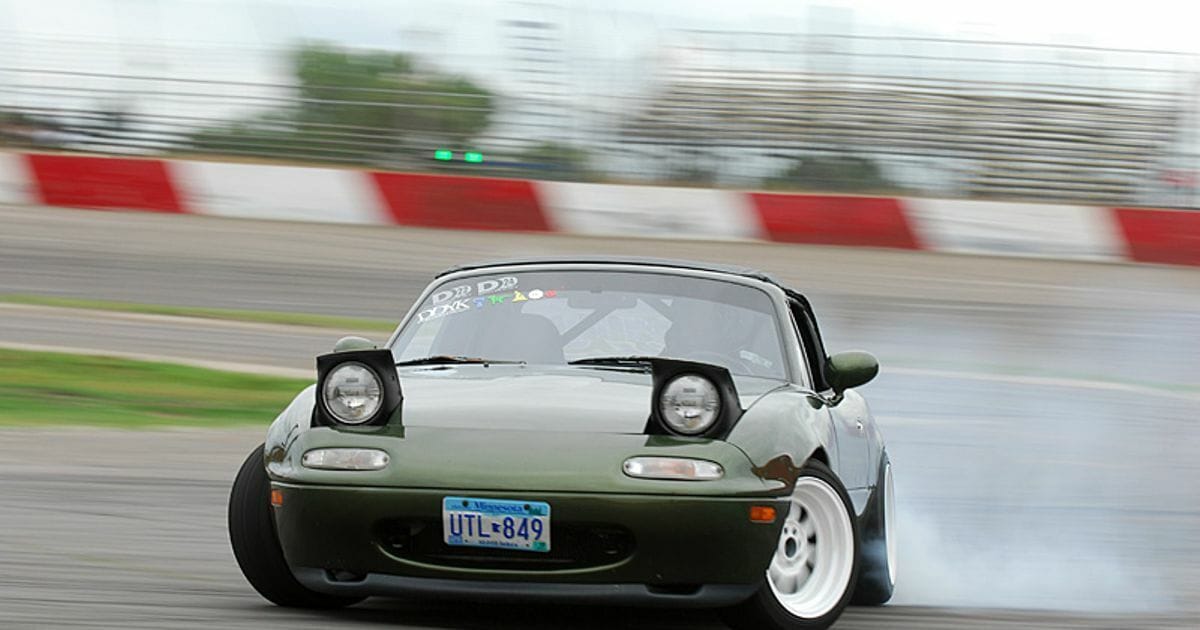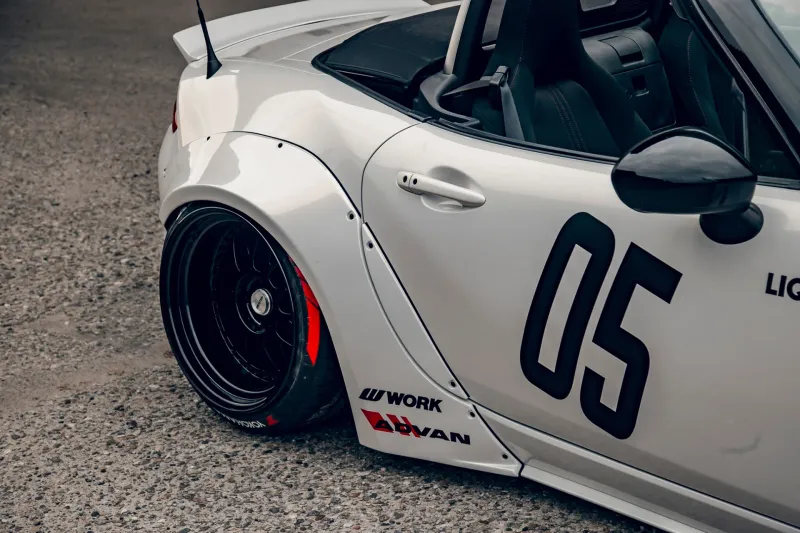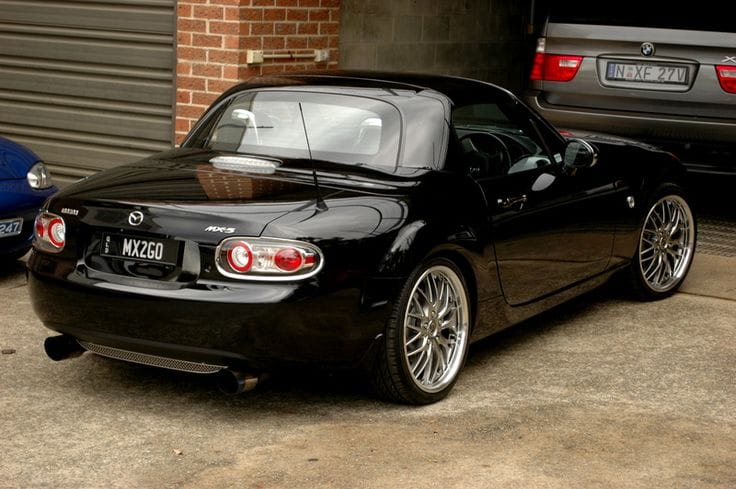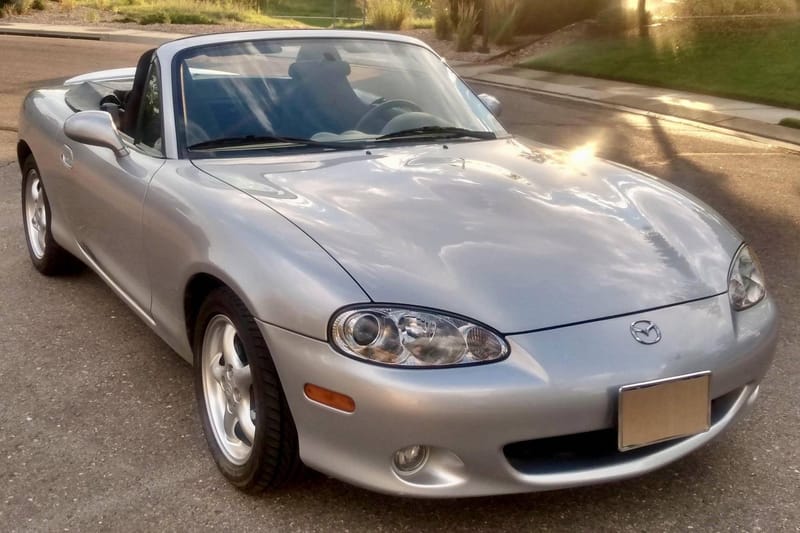The Miata as a Drifting Machine: Building a Drift-Ready Setup
Forget big power—drifting an NA Miata is all about mastering technique. Its light weight, short wheelbase, and low cost make it the ideal platform to learn throttle control, weight transfer, and precision. With a huge parts market and solid fundamentals!

When people first think of drifting, they might imagine turbocharged coupes with smoke pouring off wide rear tires. The NA Miata, by contrast, is small, lightweight, and known more for nimble cornering than big, smoky slides. Still, that’s exactly what makes it such a great teacher. Because it’s light, it doesn’t need a high-powered engine to break the rear end loose. You learn to make the most of momentum, weight transfer, and clutch kicks rather than brute force. The Miata is also relatively affordable, with a gigantic aftermarket full of both performance and replacement parts. Plus, if you want to eventually move on to a more powerful drift build, the fundamentals you pick up in an underpowered car will carry over seamlessly. Do keep in mind that the NA’s short wheelbase demands you be smooth on the controls. It can snap into oversteer quickly, which forces you to become a more precise driver. Remember that there’s no one-size-fits-all approach here, these guidelines are just a starting point to help you figure out your ideal setup.
Initial Inspection
Before investing a bunch of cash in fancy parts, you need to ensure your Miata isn’t suffering from terminal rust or worn-out basics. Rust can plague the NA in crucial areas like rocker panels, frame rails, and underneath the battery tray, so give those zones a thorough inspection. Also, worn bushings and ball joints cause alignment changes and vague handling, which isn’t helpful when you’re trying to hold a drift. It’s worth replacing them if they’re tired, and it’s wise to upgrade to polyurethane bushings, at least in some parts of the car, if you’re after improved steering response. Some drivers prefer poly in the rear and a mix of rubber and poly up front to balance comfort and performance, while others might go full poly or even spherical bearings if they’re very serious about track use.
Another factor to watch is the cooling system. Drifting puts the engine under continuous stress and often sees it revving high without the airflow that comes from normal highway speeds. If your radiator and hoses are weak, you could end up with overheating issues. Make sure you have a healthy cooling setup to avoid cutting track sessions short.
Suspension and Coilovers
The most common starting point for modifying any drift car is the suspension, and in the Miata’s case, coilovers are near the top of the list. Coilovers let you adjust your ride height, spring rates, and damping so you can dial in the balance that works best for both your skill level and drifting style. They reduce body roll and give sharper steering compared to stock suspension. While cheap coilovers can get the job done, especially for a beginner on a budget, they may not last under the punishment of frequent drifting.

When choosing spring rates, keep in mind that you want enough stiffness to control body roll without making the car bounce around on rough surfaces. Also, avoid the temptation to slam the Miata super low, because you’ll quickly run into suspension geometry issues and might struggle with bump steer mid-drift. As for alignment, many drift Miatas run a bit more negative camber and some toe-out up front to improve turn-in, with a slight toe-in at the rear for stability during transitions. Experiment with caster, too, since more caster angle will help the steering return to center more forcefully, handy for catching slides in a hurry.
Increasing Steering Angle
One of the biggest challenges in drifting a short-wheelbase car like the NA Miata is preventing spin-outs once the rear end starts to come around. Adding more steering angle gives you a greater range to catch and hold the slide. There are a couple of ways to do this: either modifying (“chopping”) knuckles or adding rack spacers. Modified knuckles shorten the steering arm, which means you can turn the wheels further and faster, but you need to have them properly welded with good penetration and alignment. Budget rack spacers are simpler, these let your steering rack move the tie rods a bit more, increasing lock.

If you shorten your knuckles, you may need to shorten or reinforce the tie rods as well. This is often done by cutting and sleeve-welding, with a reinforcing collar to keep things safe and strong. When you’re finished, be sure to realign the front end. Drifting with wonky alignment can give you unpredictable steering, which is definitely not what you want.
Differential Options
To drift properly, both rear wheels need to spin together. The Miata usually comes with an open diff (unless it’s an LSD-equipped model), so you either need a limited-slip differential or a welded diff to keep those rear tires locked together. A Torsen or clutch-type LSD is the preferred choice if your budget allows, LSDs are smoother and make the car more predictable through transitions, without the downsides of tire chirping at low speeds. A welded diff, on the other hand, is cheap and effective, just less refined. You’ll definitely notice it in tight corners or parking lots when the inside tire skips and chirps.
If you decide to drop the diff and weld it, or replace it with an LSD, make sure you inspect the Power Plant Frame (PPF), axle seals, and diff brackets. The NA Miata’s front diff bracket can crack under stress, so reinforce it if you plan on frequent clutch kicks. This is also a great time to replace fluid and give your axles a once-over.
Wheels and Tires
For an underpowered Miata, going with a smaller diameter wheel (15-inch is a sweet spot) and narrower tires at the rear can make drifting easier, since it reduces rolling resistance and demands less torque to spin the wheels. Running stickier tires up front helps with steering precision, letting you hold and control your angle better. Out back, cheaper or slightly older tires are a fine choice when you’re learning, because you’ll be burning through them quickly anyway. Bumping up the rear tire pressure (somewhere around 40 psi or even more) helps the rear end break loose and stay in a slide, compensating for the Miata’s modest torque output.
Handbrake Upgrades
The stock Miata handbrake isn’t known for its potency. Drifters often refresh the brake pads, adjust the handbrake cable, or do a simple “drift button” mod that prevents the handbrake from clicking into place. This makes it easier to yank and release it in quick succession, which is helpful for initiating drifts. If you’re really serious about using the handbrake for initiations or adjusting angle mid-drift, consider installing a hydraulic handbrake. A hydro handbrake taps into the rear brake lines and provides far stronger clamping force, although it’s an added cost and requires some careful install work.

Drivetrain and Clutch
Drifting any car involves a lot of clutch kicking if you’re underpowered, and the Miata certainly falls under that category. An upgraded clutch, like a Stage 1 or Stage 2, can handle the repeated shock loads and heat that come from hammering the clutch at high RPM. Since you’ll already be dropping the transmission, it’s a good time to inspect or replace the flywheel, throwout bearing, and pilot bearing.
If you find yourself craving more power after getting comfortable with drifting, forced induction is on the table. A small turbo or supercharger kit can drastically increase torque, making it easier to maintain a drift. However, more power means more stress on the diff, axles, and clutch, so make sure your drivetrain is beefed up accordingly.
Maintenance and Reliability
Drifting hammers on a car’s mechanicals, no question. Make a habit of checking fluid levels, engine, diff, and transmission, after events. Regularly inspect bushings, tie rods, and suspension bolts, as they can loosen or wear out faster under drifting conditions. Stress cracks can appear around coilover mounts, the diff bracket, and even modified knuckles if the welding wasn’t done perfectly. Catching small issues early can save you major headaches (and expenses) down the line.
At the end of the day, the most important component of any drift build is the driver. Seat time at skid pad events or organized drift days will fast-track your learning curve. The NA Miata, with its modest power and lively chassis, can make you a better driver simply by demanding precise inputs. Sure, you’ll probably spin out a few times, but that’s part of the fun, and the learning process.
Remember to start with a healthy car: address rust, bushing wear, and leaks before piling on the performance mods. From there, a decent set of coilovers and a proper diff (welded or LSD) are your main steps toward consistent drifting. If you’re feeling adventurous, mild steering-angle mods will help you hold bigger slides. Stay on top of maintenance, since drifting pushes components to their limits, and keep in mind that driver skill beats raw horsepower when it comes to really mastering the art of going sideways.
One final tip: don’t be afraid to share or read stories from other Miata drifters. Whether it’s the nightmare of removing a seized axle, the hilarity of mixing front and rear coils by accident, or learning the hard way that your diff bracket was on its last legs, these lessons are what make building a drift car such an adventure. Good luck, and enjoy that glorious feeling of a perfectly executed slide in your Miata!




